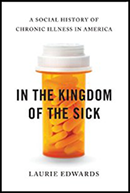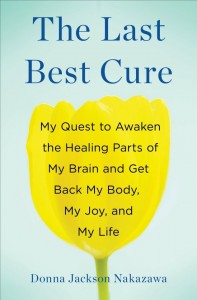If you’ve read this blog for awhile, you know how important I think discussing the impact of chronic illness on relationships is. I’ve followed Barbara Kivowitz’s wise, thoughtful writing about all of this for years, and I am pleased to share that she has co-authored a new book with so many helpful insights, perspectives, and advice. In Sickness As In Health pubs today, and you can find out more about it and the challenges of navigating illness in relationships in the Q&A we did:
1. Can you tell readers a little bit about how your own journey as a patient, a partner, and a professional led you to co-writing this book?
The short story is that my coauthor and I each lived the experience of being the ill person in our relationships and were stunned by how much the illness subverted our customary patterns of connecting with our husbands, and by how important our husbands were to our healing. Illness became the third partner, entering into the living room, the kitchen, and the bedroom at will. And there was nothing out there to help couples learn how to move though the illness experience together from both relational and practical perspectives. We decided to write In Sickness As In Health so that couples could learn from each other’s stories and get practical advice from experts in different fields.
The longer story is that I, like most healthy people who enter into a committed relationship, never took the “in sickness” and “for worse” parts of the vows seriously. They were words not predictions. For others, not us.
However, when I was in my late forties and had been married for fifteen years, I got slammed by a mysterious chronic pain condition. It didn’t take long to realize that while the pain resided in my body, both our lives were radically dislocated. As partners, we had been used to being different but equal and sharing the load. We were ordinary, and had no idea what a gift that was. Then I went from being an active psychotherapist and outdoorswoman to a puddle of anguish and uncertainty. My partner, a scientist and technologist had a massive problem he could not solve and devolved to being a helpless witness. All of my empathy and intuition and all of his analytic abilities could not make the pain go away.
Suddenly, pain was the dominant partner in our relationship and our customary tools and ways of connecting were no longer adequate. We went from being equals to being patient and caregiver, roles neither of us knew or liked. For example: I was used to sensing other people’s needs, not expressing my own, so when I was in the grip of a pain episode and regressed to being a crying child wanting to be held, I had to learn to figure out and boldly ask for exactly what I needed. Richard, the arch problem solver, had to learn to just “be” with me and not keep trying to “do” for me. Over time, we had to learn how to reorient our roles to accommodate pain and how to communicate at more honest, deeper levels more quickly because we were both too exhausted to equivocate.
I wanted to hear what it was like for other couples living with illness, so I began my blog In Sickness As In Health. I heard so many profound stories that I realized there is a book here. Our book combines couples’ stories, with relationship and practical advice from experts; and hopefully will help readers not only find tools they can use but also a way to feel less alone.
2. In the book you write you learned that “under extraordinary circumstances, people can rise to the extraordinary; that illness can be a gateway and not an epilogue; and that even in the absence of a cure, healing is possible.” That distinction between a cure and healing is so important, especially since most people with chronic illness will not receive a cure. In brief, what does that healing look like?
Anne Frank wrote in her diary, “Where there is hope there is life.” I would humbly add that where there is hope there is healing. And there is always something to hope for, even when a physical cure becomes unlikely. You can hope for love and rectification of important relationships. You can hope for greater spiritual awareness. You can hope for comfort. You can hope to help someone else. You can hope to make one small corner of the world a better place.
Hope moves us towards the light; and in that light we may be able to see something that was hidden before. And that something can be the piece we need to complete a critical part of ourselves. I think of healing as becoming more than who we were a moment ago. And that is always possible.
3. You write of three dimensions of illness—the crisis, a balancing act, and regaining equilibrium. A common thread among these stages seems to be an ongoing adaptation of roles. What is your biggest piece of advice in terms of how to navigate new roles within a relationship while still maintaining one’s identity?
This is a great question and a complex one. You could justifiably argue that we change our identities many times in the course of a relationship – parenthood, new career, death of an adult parent. Identity flexibility in this context is a healthy adaptation and allows us to keep our balance when the tectonic plates under our relationship shift. On the other hand, you could also say that our identity is our inner fixed point, our immutable sense of who we are, and that nothing diverts it. It serves to ground us wherever we wind up and lends us ballast.
Whichever approach to identity you prefer, one piercing piece of identity wisdom I was given when I first got sick was: “I have pain. I am not my pain.” You have an illness, but you are not your illness. Over time, it can become easier to lose your sense of yourself as a being that is bigger than your illness. You may need to change roles to cope with the demands of your illness, but you do retain that essence of self that extends above the illness. Think of roles as the cloaks you wrap around your identity to help you accommodate to shifts illness may require of you.
In my situation, I remained an intuiter and my husband remained a problem solver, but our roles quickly became that of patient and caretaker. These roles lasted for a year, and we slide back into them when I have a relapse. My coauthor suffered a serious stroke, and her husband consciously decided not to take on the role of caretaker but rather to maintain his identity as her adult partner and have aides do the daily care. There are many permutations, and each couple ultimately figures out its own way.
Role adaptability is how we achieve balance in our relationship, how we complement each other’s capabilities. Illness can cause imbalance, and we then need to purposefully recalibrate our roles.
Here’s some advice for maintaining a healthy role balance:
- Notice: pay attention to the cues (in both partners) that tell you things are off track – illness symptoms, stress symptoms, energy levels, irritability, distance, things not getting done
- Talk and Listen without problem solving: pick a time when you are unlikely to be interrupted and alternate saying to each other these six statements. Do not discuss. Only ask questions for clarification:
- I feel…
- I fear…
- I hope…
- I want…
- Here’s what I appreciate about you…
- I love you.
- Pick one or two changes you’d like to make and offer them to your partner
- Pick one or two changes you’d like your partner to make and ask him/her to consider them
This is not a linear, problem solving approach to role modification. In fact it may take time for changes to be noticed. The intention with this approach is to work as partners, not adversaries, to name and honor the emotions that underlie any role agitation, to describe the changes you can give and would like to receive, and to consciously adapt your roles in as constructive a manner as possible.
4. Many of the compelling stories you weave into the text involve couples that faced a sudden change in health status. What major takeaways can you give to those couples for which illness has always been part of the relationship? There isn’t the same “before” and “after,” yet these couples face their own unique challenges.
Illness, as those of us who live with it know, is fluid, even capricious. Periods of stability alternate with periods of relapse. I had been doing really well for many years when suddenly some damn butterfly in Beijing flapped its polluted wings, and I suffered a massive pain relapse. As your illness changes, the “before” and “after” become part of the rhythm of your lives.
However, entering a relationship with illness does bring certain challenges. Intimate questions like what to tell (and show) and when to do so can arise even before you know each other’s favorite ice cream flavor. Having illness as part of the landscape right from the outset can force authentic communication. This can be tough, but also a gift. One couple we interviewed had to deal with one partner’s kidney failure about a year after they first met. The illness accelerated their connection and forced them to think deeply about their relationship and to speak with powerful honesty about their needs and limits.
I think that for couples for whom illness is present at the start of the relationship, the need for regular communication and clear role definition may be more acute. If these couples can learn how to connect and partner authentically in the arena of illness, they may be able to transfer that ability to other areas of their relationship. As one of our interviewees said “Illness can be a great teacher, if you let it.”
And, remember, that we have an illness but we are not our illness. There are still many galaxies to explore with your partner out of the range of illness.
* * *
Thanks so much, Barbara!








